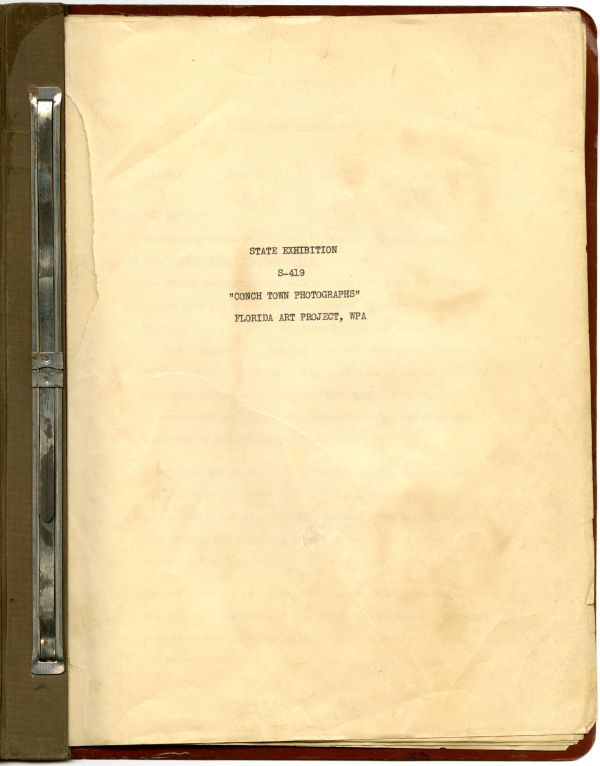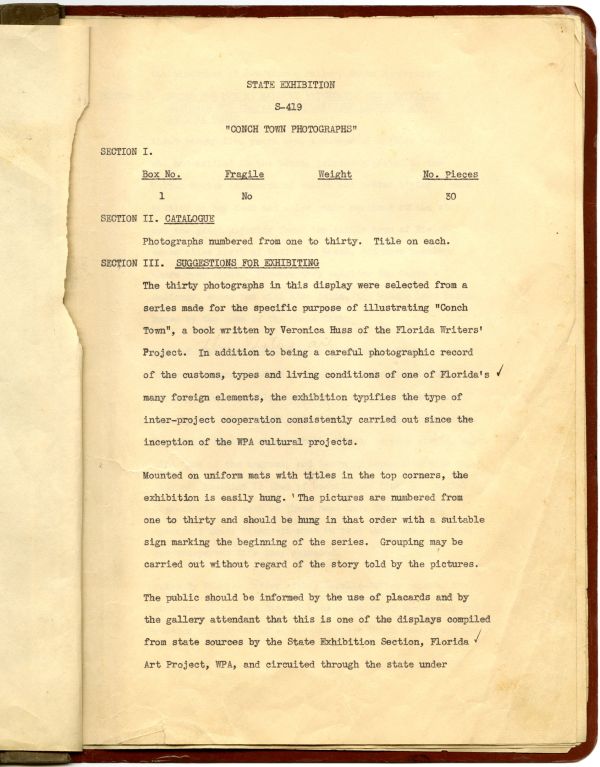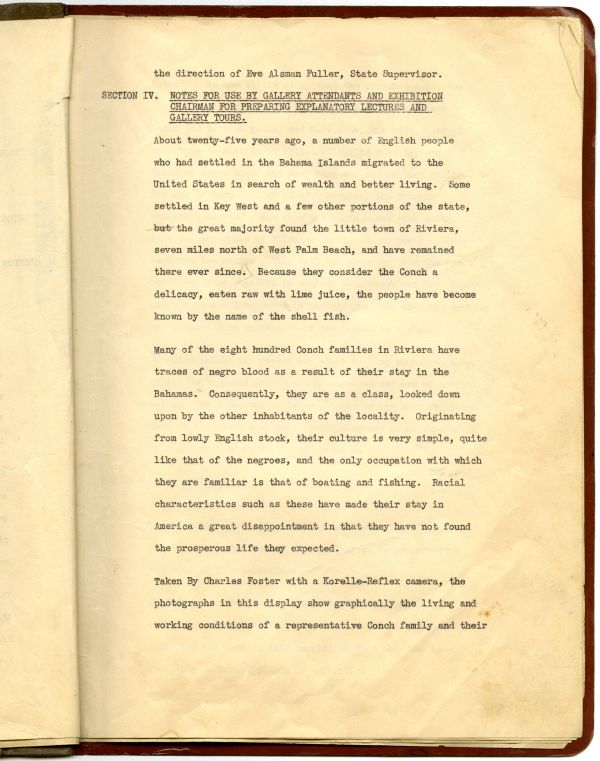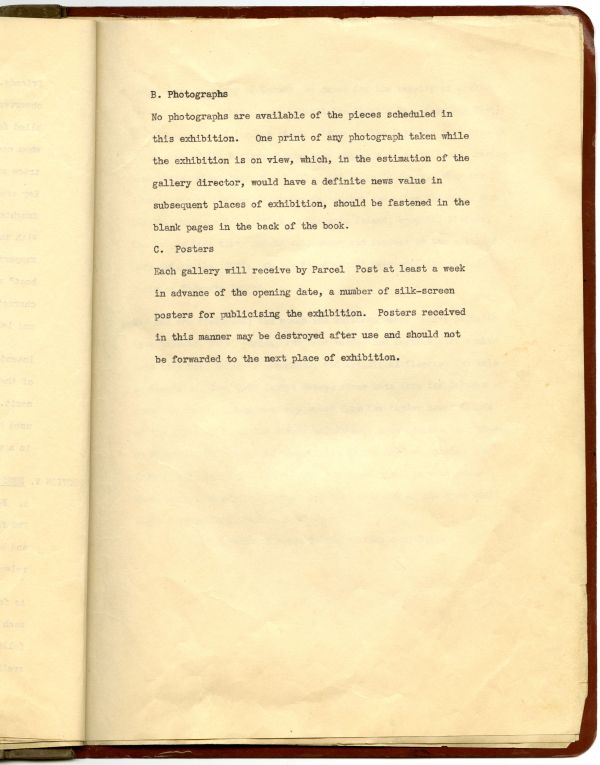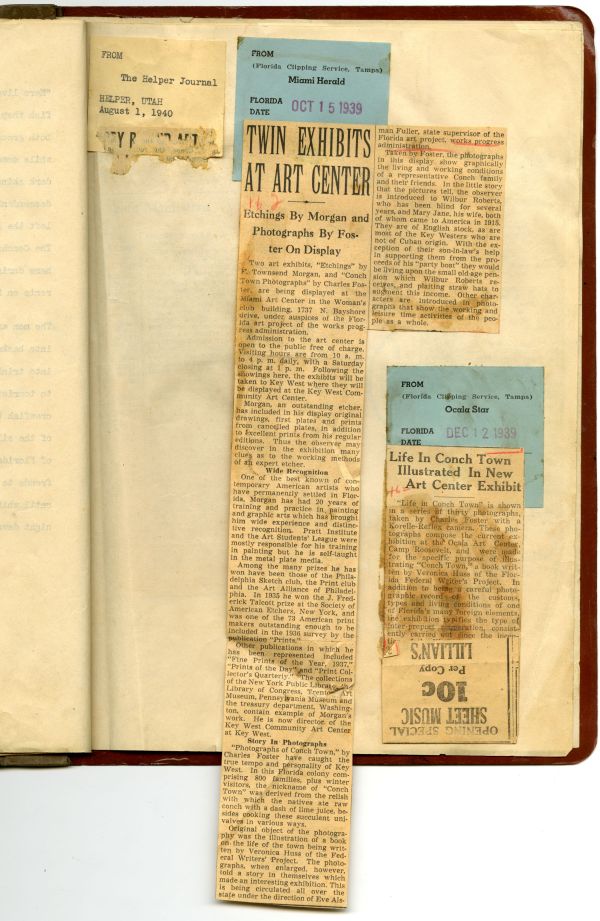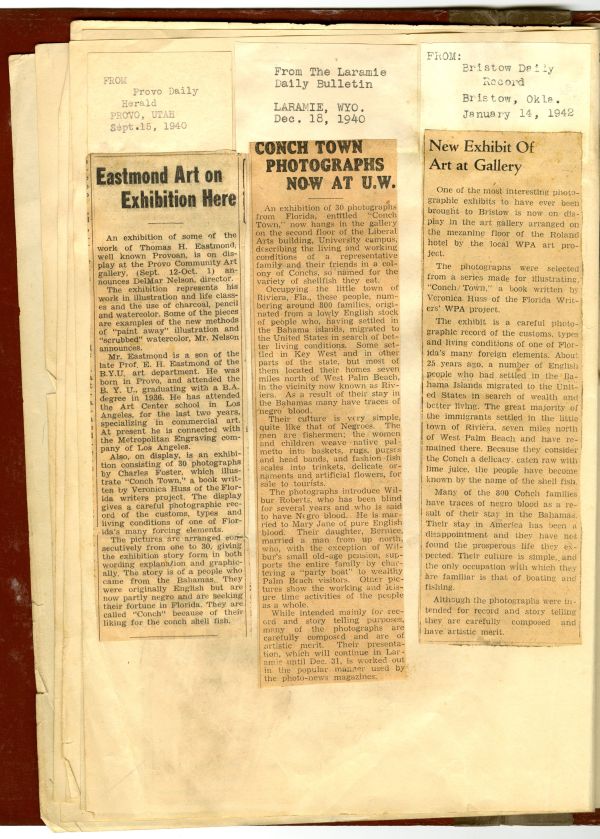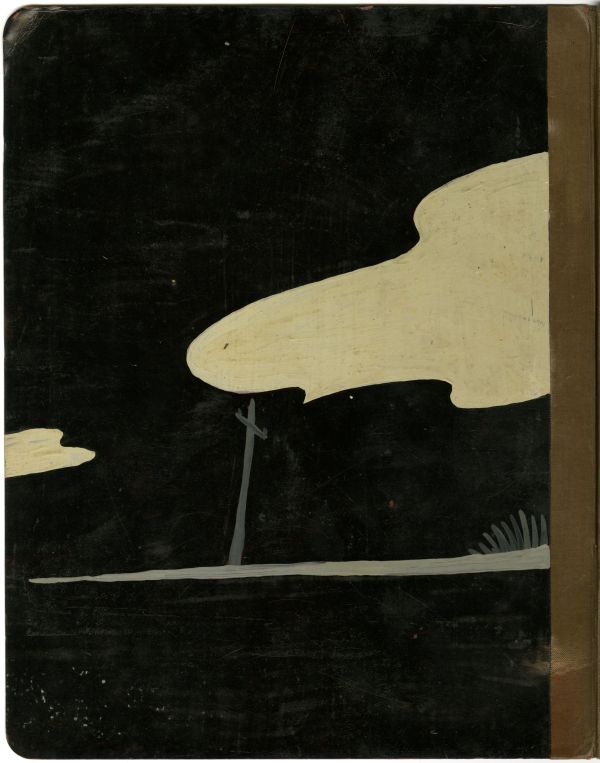Transcript
CONCH TOWN
PREPARED BY
FLORIDA ART PROJECT
WPA
STATE EXHIBITION
S-419
"CONCH TOWN PHOTOGRAPHS"
FLORIDA ART PROJECT, WPA
STATE EXHIBITION
S-419
"CONCH TOWN PHOTOGRAPHS"
SECTION I.
Box No. : 1
Fragile : No
Weight :
No. Pieces : 50
SECTION II. CATALOGUE
Photographs numbered from one to thirty. Title on each.
SECTION III. SUGGESTIONS FOR EXHIBITING
The thirty photographs in this display were selected from a series made for the specific purpose of illustrating "Conch Town", a book written by Veronica Huss of the Florida Writers' Project. In addition to being a careful photographic record of the customs, types and living conditions of one of Florida's many foreign elements, the exhibition typifies the type of inter-project cooperation consistently carried out since the inception of the WPA cultural projects.
Mounted on uniform mats with titles in the top corners, the exhibition is easily hung. The pictures are numbered from one to thirty and should be hung in that order with a suitable sign marking the beginning of the series. Grouping may be carried out without regard of the story told by the pictures.
The public should be informed by the use of placards and by the gallery attendant that this is one of the displays compiled from the state sources by the State Exhibition Section, Florida Art Project, WPA, and circulated through the state under
the direction of Eve Alsman Fuller, State Supervisor.
IV. NOTES FOR USE BY GALLERY ATTENTANDS AND ECHIBITION CHAIRMAN FOR PREPARING EXPLANATORY LECTURES AND GALLERY TOURS.
About twenty-five years ago, a number of English people who had settled in the Bahama Islands migrated to the United States in search of wealth and better living. Some settled in Key West and a few other portions of the state, but the great majority found the little town of Riviera, seven miles north of West Palm Beach, and have remained there ever since. Because they consider the Conch a delicacy, eaten raw with lime juice, the people have become known by the name of the shell fish.
Many of the eight hundred Conch families in Riviera have traces of negro blood as a result of their stay in the Bahamas. Consequently, they are as a class, looked down upon by the other inhabitants of the locality. Originating from lowly English stock, their culture is very simple, quite like that of the negroes, and the only occupation with which they are familiar is that of boating and fishing. Racial characteristics such as these have made their stay in America a great disappointment in that they have not found the prosperous life they expected.
Taken by Charles Foster with a Korelle-Reflex camera, the photographs in this display show graphically the living and working conditions of a representative Conch family and their
friends. In the little story that the pictures tell, the observer is introduced to Wilbur Roberts, who has been blind for several years, and Mary Jane, his wife, both of whom came to America in 1915. Wilbur is said to have a trace of negro blood but Mary Jane and her brother Willie Key are of pure English blood. Bernice, the Roberts' daughter, married a man from the north named Dick Smith. With the exception of Wilbur's small old age pension, Dick supports the entire family with the proceeds from the "party boat" which he charters to wealthy Palm Beach people. Other characters are introduced in photographs that show the working and leisure time activities of the people as a whole.
Intended mainly for record and story telling purposes, many of the photographs are carefully composed and are of artistic merit. The presentation is worked out in the popular manner used by the photo-news magazines and serves as an experiment in a new type of exhibition preparation.
SECTION V. NEWS SERVICES
A. News Releases
The foregoing information may be used by gallery directors and by representatives of the local press to prepare news releases on this exhibition.
As far as possible, clippings or typewritten copies of each news release should be inserted in the blank pages following the text of this booklet so that they may be available to future places of exhibition.
B. Photographs
No photographs are available of the pieces scheduled in this exhibition. One print of any photograph taken while the exhibition is on view, which, in the estimation of the gallery director, would have a definite news value in subsequent places of exhibition, should be fastened in the blank pages in the back of the book.
C. Posters
Each gallery will receive by Parcel Post at least a week in advance of the opening date, a number of silk-screen posters for publicizing the exhibition. Posters received in this manner may be destroyed after use and should not be forwarded to the next place of exhibition.
"Here lives a colony of Conchs, so named for the variety of shell-fish they eat. Other Conchs inhabit the Florida Keys (See Key West); both groups are of English stock. Those on the Keys are part Spanish while some of the Riviera Conchs bear evidence of Negro blood, having dark shins, kinky hair, thick lips, and heavy features. Many are descendants of English fishermen who during and after the World War left the Bahamas and settled on Singer's Island, opposite Riviera. The Conchs left their island settlement and removed to the mainland here during the 1020's, when a "land shark" extravagantly raised rents on Singer's Island.
The men are fishermen; the women and children weave native palmetto into baskets, rugs, purses, and head bands, and fashion fish scales into trinkets, delicate ornaments, and artificial flowers, for sale to tourists. They also import Nassau straw hats from the Bahamas on crawfish boats. These hats are woven from the tender inner fronds of the silver-top and the Bahama palmettos, more durable than those of Florida. Shredded into long strips of the desired widths, the frond to be woven into straw hats are first baked in rock ovens until white and properly cured, and then laid out in the open until night dews restore their pliability."
----FLORIDA: A Guide To The Southernmost State
[Clipping 1]
FROM
The Helper Journal
Helper, Utah
August 1, 1940
(newspaper clipping torn away)
[Clipping 2]
FROM
(Florida Clipping Service, Tampa)
Miami Herald
Florida
Date OCT 14 1939
TWIN EXHIBITS AT ART CENTER
Etchings By Morgan and Photographs By Foster On Display
Two art exhibits, "Etchings" by F. Townsend Morgan, and "Conch Town Photographs" by Charles Foster, are being displayed at the Miami Art Center in the Woman's club building, 1737 N. Bayshore Drive, under auspices of the Florida art project of the works progress administration.
Admission to the art center is open to the public free of charge. Visiting hours are from 10 a.m. to 4 p.m. daily, with a Saturday closing at 1 p.m. Following the showings here, the exhibits will be taken to Key West, where they will be displayed at the Key West Community art Center.
Morgan, an outstanding etcher, has included in his display original drawings, first plates and prints from cancelled plates, in addition to excellent prints from his regular editions. Thus the observer may discover in the exhibition many clues as to the working methods of an expert etcher.
Wide Recognition
One of the best known of contemporary American artists who have permanently settled in Florida, Morgan has had 20 years of training and practice in painting and graphic arts which has brought him wide experience and distinctive recognition. Pratt Institute and the Art Students' League were mostly responsible for his training in painting but he is self-taught in the metal plate media.
Among the many prizes he has won have been those of the Philadelphia Sketch club, the Print club and the Art Alliance of Philadelphia. In 1935 he won the J. Frederick Talcott prize at the Society of American Etchers, New York, and was one of the 73 American print makers outstanding enough to be included in the 1936 survey by the publication "Prints."
Other publications in which he has been represented included "Fine Prints of the Year, 1937", "Prints of the Day", and "Print Collector's Quarterly." The collections of the New York Public Library , the Library of Congress, Trent (illegible due to torn page) Art Museum, Pennsylvania Museum and the treasury department, Washington, contain example (sic) of Morgan's work. He is now director of the Key West Community Art Center at Key West.
Story in Photographs
"Photographs of Conch Town," by Charles Foster have caught the true tempo and personality of Key West. In this Florida colony comprising 800 families, plus winter visitors, the nickname of "Conch Town" was derived from the relish with which the natives ate raw conch with a dash of lime juice, besides cooking these succulent univalves in various ways.
Original object (sic) of the photography was the illustration of a book on the life of the town being written by Veronica Huss of the Federal Writers' Project. The photographs, when enlarged, however, told a story in themselves which made an interesting exhibition. This is being circulated all over the state under the direction of Eve Alsman Fuller, state supervisor of the Florida art project, works progress administration.
Taken by Foster, the photographs in this display show graphically the living and working conditions of a representative Conch family and their friends. In the little story that the pictures tell, the observer is introduced to Wilbur Roberts, who has been blind for several years, and Mary Jane, his wife, both of whom came to America in 1915. They are of English stock, as are most of the Key Westers who are not of Cuban origin. With the exception of their son-in-law's help in supporting them from the proceeds of his party boat" they would be living upon the small old-age pension which Wilbur Roberts receives, and plaiting straw hats to augment this income. Other characters are introduced in photographs that show the working and leisure time activities of the people as a whole.
[Clipping 3]
FROM
(Florida Clipping Service, Tampa)
Ocala Star
Florida
Date DEC 12 1939
Life In Conch Town Illustrated IN New Art Center Exhibit
"Life in Conch Town" is shown in a series of thirty photographs, taken by Charles Foster with a Korelle-Reflex camera. These photographs compose the current exhibition at the Ocala Art Center, Camp Roosevelt, and were made for the specific purpose of illustration "Conch Town," a book written by Veronica Huss of the Florida Federal Writers' Project. In addition to being a careful photographic record of the customs, types and living conditions of one of Florida's many foreign elements, the exhibition typifies the type of inter-project cooperation, consistently carried out since the inception of the W.P.A. cultural projects.
In the little story that the pictures tell, the, the observer is introduced to Wilbur Roberts and Mary Jane, his wife, both of whom came to American in 1915. The story goes that about twenty-five years ago a number of English people migrated from the Bahama Islands to the United States in search of wealth and better living. Some settled in Key West but the majority found a little town of Riviera, seven miles north of West Palm Beach, and have remained there ever since. Because they consider the conch a delicacy, eaten raw with lime juice, the people have become known by the name of the shell fish.
Intended mainly for record and story telling purposes, many of the photographs are carefully composed and are of artistic merit.
[Clipping 1]
FROM
Provo Daily Herald
PROVO, UTAH
Sept. 15, 1940
Eastmond Art on Exhibition Here
An exhibition of some of the work of Thomas H. Eastmond, well known Provoan, is on display at the Provo Community Art gallery, (Sept. 12-Oct.1) announces DelMar Nelson, director.
The exhibition represents his work in illustration and life classes and the use of charcoal, pencil and watercolor. Some of the pieces are examples of the new methods of "paint away" illustration and "scrubbed" watercolor, Mr. Nelson announces.
Mr. Eastmond is a son of the late Prof. E.H. Eastmaond of the B.Y.U. art department. He was born in Provo, and attended the B.Y.U., graduating with a B.A. degree in 1936. He has attended the Art Center school in Los Angeles, for the last two years, specializing in commercial art. At present he is connected with the Metropolitan Engraving company of Los Angeles.
Also, on display, is an exhibition consisting of 30 photographs by Charles Foster, which illustrate "Conch Town," a book written by Veronica Huss of the Florida Writers project. The display gives a careful photographic record of the customs, types and living conditions of one of Florida's many forcing (sic) elements.
The pictures are arranged consecutively from one to 30, giving the exhibition story form in both wording explanation and graphically. The story is of a people who came from the Bahamas. They were originally English but are now partly negro and are seeking their fortune in Florida. They are called "Conch" because of their liking for the conch shell fish.
[Clipping 2]
From The Laramie Daily Bulletin
LARAMIE, WYO.
Dec. 18, 1940
CONCH TOWN PHOTOGRAPHS NOW AT U.W.
An exhibition of 30 photographs from Florida, entitled "Conch Town," now hangs in the gallery on the second floor of the Liberal Arts building, University campus, describing the living and working conditions of a representative family and their friends in a colony of Conchs, so named for the variety of shellfish they eat.
Occupying the little town of Riviera, Fla., these people, numbering around 800 families, originated from a lowly English stock of people who, having settled in the Bahama islands, migrated to the United States in search of better living conditions. Some settled in Key West and in other parts of the state, but most of them located their homes seven miles north of West Palm Beach, in the vicinity now known a Riviera. As a result of their stay in the Bahamas many have traces of negro blood.
Their culture is very simple, quite like that of Negroes. The men are fishermen; the women and children weave native palmetto into baskets, rugs, purses and head bands, and fashion fish scales into trinkets, delicate ornaments and artificial flowers, for sale to tourists.
The photographs introduce Wilbur Roberts, who has been blind for several years and who is said to have Negro blood. He is married to Mary Jane of pure English blood. Their daughter, Bernice, married a man from up north, who, with the exception of Wilbur's small old-age pension, supports the entire family by chartering a "party boat" to wealthy Palm Beach visitors. Other pictures show the working and leisure time activities of the people as a whole.
While intended mainly for record and story telling purposes, many of the photographs are of artistic merit. Their presentation, which will continue in Laramie until Dec. 31, is worked out in the popular manner used by the photo-news magazines.
[Clipping 3]
FROM:
Bristow Daily Record
Bristow, Okla.
January 14, 1942
New Exhibit of Art at Gallery
One of the most interesting photographic exhibits to have ever been brought to Bristow is now on display in the art gallery arranged on the mezzanine floor of the Roland hotel by the local WPA art project.
The photographs were selected from a series made for illustration, "Conch Town," a book written by Veronica Huss of the Florida Writer's WPA project.
The exhibit is a careful photographic record of the customs, types and living conditions of one of Florida's many foreign elements. About 25 years ago, a number of English people who had settled in the Bahama Islands migrated to United States in search of wealth and better living. The great majority of the immigrants settled in the little town of Riviera, seven miles north of West Palm Beach and have remained there. Because they consider the Conch a delicacy, eaten raw with lime juice, the people have become known by the name of the shell fish.
Many of the 800 Conch families have traces of negro blood as a result of their stay in the Bahamas. Their stay in America has been a disappointment and they have not found the prosperous life they expected. Their culture is simple, and the only occupation with which they are familiar is that of boating and fishing.
Although the photographs were intended for record and story telling they are carefully composed and have artistic merit.
[Clipping 1]
From:
The Booster
Edmond, Oklahoma
February 20, 1942
Photo Exhibit in W.P.A. Art Gallery
The 30 photographs that make up this exhibition were selected from a series made by Charles Foster to illustrate Conch Town, a book written by Veronica Huss of the WPA Writers' Project of Florida.
The exhibit is a careful photographic record of the customs, types, and living conditions of one of Florida's many foreign elements. The photographs, arranged consecutively from 1 to 30, tell a story themselves and make an interesting exhibit.
Altho (sic) intended mainly for record and story telling purposes, many of the photographs are carefully composed and are of artistic merit. The presentation is worked out in the popular manner used by photo-news magazines and serve as an experiment in a new type of exhibition preparation. The exhibition will remain on view until February 22.




 Listen: The Assorted Selections Program
Listen: The Assorted Selections Program